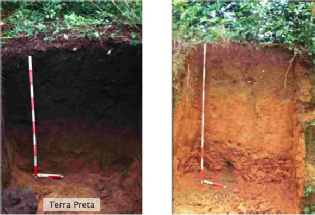

Terra Preta or Amazon Dark Soil, What it is and its composition | Biochar
6–8 minutes
Terra Preta soils
The ancient soil that could help agriculture and the climate today

Terra Preta is often referred to as Amazon fertile/dark/black/super soil or Indian black earth. In Portuguese, it is known as Terra Preta do Indio. It’s a highly fertile anthropologic (man-
This “circular living system” where the inert elements provide the perfect conditions for the mycorrhizal fungi and microorganisms to thrive. These promote amazing soil health, which in turn drives better plant health and crop yield above the ground.
Terra Preta soils are very different from the surrounding tropical soils. These are notoriously thin and nutrient-
Color and composition
Terra Preta has a characteristic dark colour due to the black carbon/charcoal/biochar content incorporated in it. For the purposes of today’s context, it would have contained partially burnt wood, charcoal, biochar and ash. We will refer to this as biochar (see differences here). During recent sampling, it was found to contain local brown soil (Terra Mulata*), biochar and shards of pottery.
*Terra Mulata is essentially larger farmed areas. Here it is likely the less fertile clay/silt/sand-
Note: The image above is Cross sectional profiles 1 meter deep comparing Terra Preta on the left, with nearby Oxisol on the right of the type that is normally found in the Amazon basin. courtesy of the paper Glaser B, Haumaier L, Guggenberger G, Zech W 2001 The Terra Preta phenomenon – a model for sustainable agriculture in the humid tropics. Naturwissenschaften 88: 37-
Our thoughts on how the man-made elements got into the soil by accident or by design?
Since the dawn of time, humans have needed shelter, food and water to survive. Hunter-
Fires would have been needed for heat at night and to cook food. As a result, the fire would have produced small amounts of charcoal/ash. Also in preparing food there would have been organic food waste from plant materials to fish skin and animal bones. Finally, each family/small community would have produced human waste. This waste may have accumulated in small piles or middens and left to rot. A few weeks or months later the wastes would transform into compost and enrich the surrounding soil.
Seeds in the diet of these early settlers would have passed through them and into the middens. In turn new plants would have grown. We see evidence of this same process today in piles of compost or solid human sewage. Also, plants in the surrounding soil may have started to flourish around these small mounds of decaying material.
Larger populations lead to civilization and agriculture
The settled way of life with improved agriculture often leads to population growth with luck civilisation follows. To sustain a large population you must have a large and ‘reliable’ food source to feed everyone. It is a surmise on our part, but once these settlers had noted the effects of their middens there was no stopping them. They had invented a new form of agriculture.
As the settler population grew more food they needed more food, so each process got a little more industrialised. The settlers may also have used fires or clay kilns to burn trees and plant materials to create charcoal. Alternatively, they may have burnt the trees and plant life directly where it stood and this provided organic carbon amendment to the surrounding soil, similar to the result of a forest fire.
The community transported their wastes, human/animal in clay pots to larger ‘landfill’ sites. This may also have helped to prevent the spread of disease. We know that biochar acts as an odour suppressor, so this may also have also been a driver for adding it onto these piles.
The above is our representation of how it may have come about, but none of it is proven.
The Terra Preta story
First accounts of Terra Preta came about when Spanish Conquistador, Francisco de Orellana recounted tales of his 1542 exploration of the Rio Negro in Brazil in his search for El Dorado and its vast gold/riches. He explained that he had seen villages, farming communities and even walled cities along the banks of the river. This suggested a civilisation with a need for vast quantities of food to sustain itself. In turn this needs fertile soil.
At the time scientists believed that the soil in the rainforest was not fertile enough to sustain a large community. They dismissed his stories as lies. In recent times scientists have visited the areas in question. They have found evidence to support the stories that Orellana recounted all those years ago.
The BBC’s Horizon programme produced a documentary on El Dorado in 2002, which included lots of information on Terra Preta. Sadly the BBC website no longer hosts the programme, but you may be able to find it elsewhere.
How do you make Terra Preta soil for your garden?
The great news is that you can make your own homemade version of Terra Preta with some simple ingredients. In its simplest form, all you need is your own compost (self-
Want to buy Terra Preta? A UK version is available
In the UK you can’t buy the actual Amazonian Terra Preta. Hopefully you wouldn’t want to. You would be pillaging it from its natural place of origin. However, you can buy UK made Terra Preta. We will list suppliers in due course.
